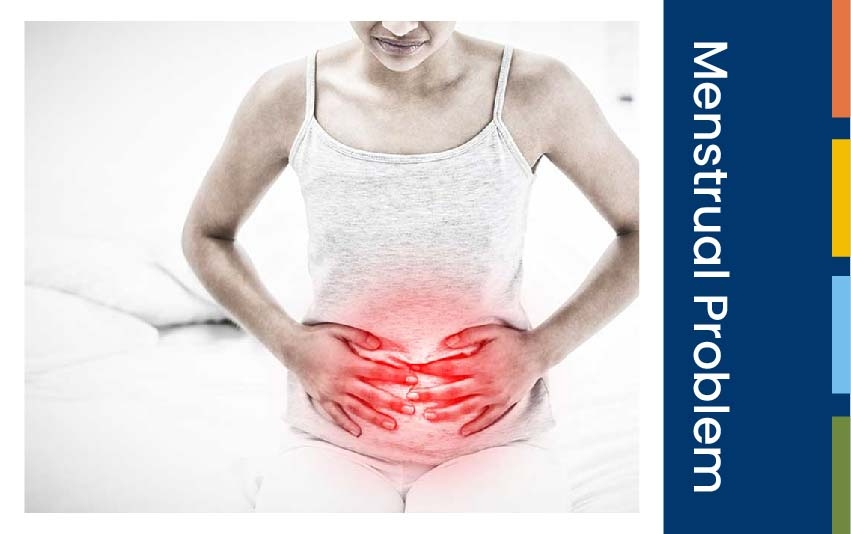
- Menstrual problems are issues related to a woman’s menstrual cycle — the monthly process of ovulation and menstruation that prepares the body for pregnancy. These problems can vary in type, severity, and impact on daily life. Here’s a detailed breakdown of common menstrual problems, their causes, symptoms, diagnosis, and treatments:
Menstrual problems are issues related to a woman’s menstrual cycle — the monthly process of ovulation and menstruation that prepares the body for pregnancy. These problems can vary in type, severity, and impact on daily life. Here’s a detailed breakdown of common menstrual problems, their causes, symptoms, diagnosis, and treatments:
1. Types of Menstrual Problems
A. Dysmenorrhea (Painful Periods)
- Primary Dysmenorrhea: Common menstrual cramps without underlying disease.
- Secondary Dysmenorrhea: Caused by reproductive disorders (e.g., endometriosis, fibroids).
Symptoms:
- Cramping pain in the lower abdomen/back
- Nausea, vomiting
- Diarrhea
- Fatigue
B. Amenorrhea (Absence of Menstruation)
- Primary Amenorrhea: No period by age 15–16.
- Secondary Amenorrhea: Missed periods for 3+ months in women who previously had regular cycles.
Causes:
- Pregnancy (most common)
- Extreme weight loss or excessive exercise
- Polycystic Ovary Syndrome (PCOS)
- Thyroid disorders
- Pituitary tumors
- Menopause
- Medications or stress
C. Menorrhagia (Heavy or Prolonged Bleeding)
- Abnormally heavy or long periods, lasting more than 7 days or soaking through pads/tampons every 1–2 hours.
Causes:
- Hormonal imbalance (e.g., PCOS, hypothyroidism)
- Uterine fibroids or polyps
- Bleeding disorders (e.g., von Willebrand disease)
- IUDs (intrauterine devices)
- Infections
- Certain medications (e.g., blood thinners)
D. Oligomenorrhea (Infrequent Periods)
- Menstrual cycles longer than 35 days, or fewer than 6–8 periods per year.
Common in:
- PCOS
- Athletes
- Underweight women
- Those with hormonal imbalances
E. Polymenorrhea (Frequent Periods)
- Cycles that are shorter than 21 days apart.
Causes:
- Hormonal imbalance
- Stress or illness
- Thyroid issues
- Perimenopause
F. Premenstrual Syndrome (PMS) and PMDD
- PMS: Physical and emotional symptoms before menstruation.
- PMDD (Premenstrual Dysphoric Disorder): Severe form of PMS causing significant emotional disruption.
Symptoms:
- Mood swings, irritability, anxiety
- Breast tenderness
- Bloating
- Headaches
- Fatigue
2. Causes of Menstrual Problems
- Hormonal imbalances: Estrogen and progesterone fluctuations
- Reproductive conditions: PCOS, endometriosis, fibroids
- Thyroid disorders
- Medications: Birth control, antipsychotics, chemotherapy
- Lifestyle: Stress, extreme exercise, poor nutrition
- Chronic illnesses: Diabetes, autoimmune diseases
3. Diagnosis
- Medical history and symptom tracking
- Physical and pelvic exam
- Blood tests: Hormone levels, thyroid function, clotting factors
- Ultrasound: Check for fibroids, cysts, uterine abnormalities
- Endometrial biopsy
- MRI or CT scan: In complex cases
4. Treatment Options
Lifestyle and Home Remedies
- Balanced diet, exercise, hydration
- Heat therapy for cramps
- Stress management (yoga, meditation)
- Menstrual tracking apps
Medications
- NSAIDs: For pain (e.g., ibuprofen, naproxen)
- Hormonal therapies: Birth control pills, patches, IUDs
- Antidepressants: For severe PMS/PMDD
- Iron supplements: For anemia from heavy bleeding
Surgical Treatments
- D&C (Dilation and Curettage): For heavy bleeding
- Myomectomy: Remove fibroids
- Hysterectomy: Last resort, removal of uterus
- Endometrial ablation: Destroys the lining of the uterus
5. When to See a Doctor
- Periods are extremely painful or heavy
- Menstrual cycle is irregular or absent without known cause
- Symptoms disrupt daily life
- Suspected pregnancy or menopause
- Family history of reproductive disorders
Would you like me to create a comparison chart or a visual guide to these menstrual problems? Or are you interested in how diet, exercise, or natural remedies can help manage them?

